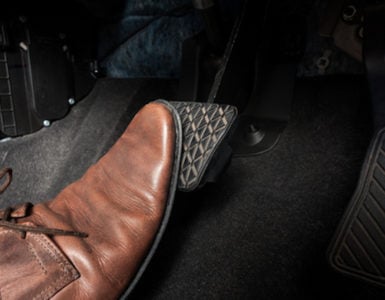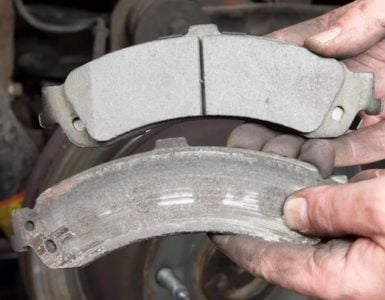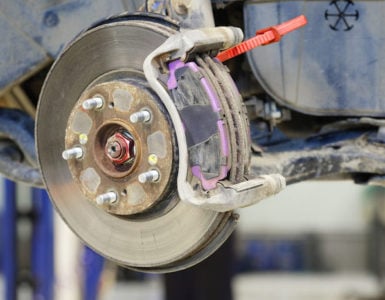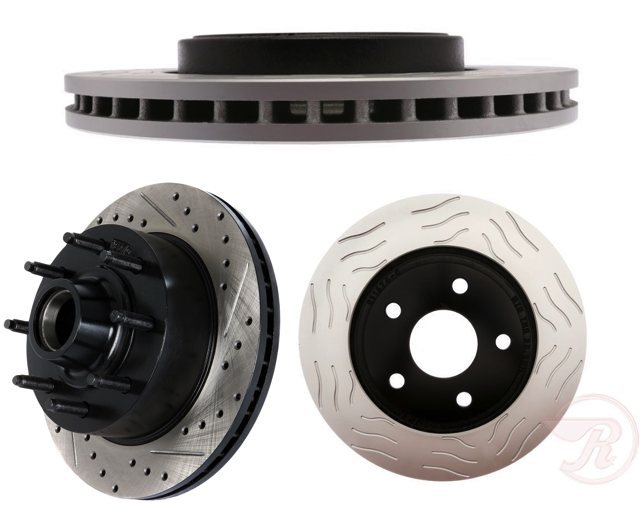
There are several different types of rotors. Aside from the traditional smooth rotors, the most common ones are:
- Slotted rotors
- Drilled rotors
- Vented rotors
To make is complicated, there are rotors on the market that combine some, or all three of the variations above. If you’re looking for upgraded rotors, you may be trying to decide on the right type for your car. It’s important to outfit your car with the right rotors that accommodate your driving style. If you’re not sure which type of rotors is right for your car and driving style, we may be able to help.
We put together this guide. It outlines the main differences between slotted rotors, drilled rotors, and vented rotors. The guide will stick to the basics and just compare rotors that have just one additional feature beyond a simple solid rotor.
What Is A Slotted Rotor?

A slotted rotor has slots machined in a spiral pattern on the rotor surface. They are about 2-3mm deep. The unique design exists for two important reasons:
- The slots keep the rotor and brake pads clean. They do this by channeling any dust, dirt, moisture, etc. on the rotor or pad surface away from the rotor. The slots send these impurities into the air, essentially.
- The slots help keep the rotor cool. The slots improve ventilation, which in turn improves heat dissipation. This is not a huge benefit, but it is noticeable enough to make slotted rotors better than smooth rotors when it comes to heat dissipation.
The Pros Of Using Slotted Rotors
Slotted rotors are more expensive than smooth rotors primarily because they take extra machining. The biggest benefits are:
1. Better Braking Performance
The slots create a good clean contact surface. They do this by removing the dust, dirt, moisture, and other impurities from the rotor and pad surfaces. This keeps these surfaces clean. When the rotor and the brake pads are clean, the pads can grip the rotors better.
This is an especially great benefit to have in wet weather. The slots etched in the rotors keep the rotors and brake pads dry, as well. This reduces your vehicle’s wet braking distance.
2. Cooler Operating Temperatures
The improved ventilation caused by slots helps keep the rotor cool. The design helps the rotor’s ability to shed heat. This makes the braking performance more reliable.
The Cons Of Using Slotted Rotors
Slotted rotors are great. Yet, they have some drawbacks: potentially faster rotor and brake pad wear. This is a common issue with inexpensive slotted rotors. Those rotors can have sharp edges around the slots. Their edges act like cheese slicer and slice away the brake pad friction material, which leads to premature wear.
There’s an easy way to avoid this problem, and it’s to buy high quality slotted rotors. At BuyBrakes.com, we only carry the highest quality brands. Some of the brands we carry include Brembo, Goodyear, and StopTech. You don’t have to worry about any sharp slot edges on the rotors we carry. Check out our selection of slotted and slotted & cross-drilled rotors today!
What Is A Drilled Rotor?
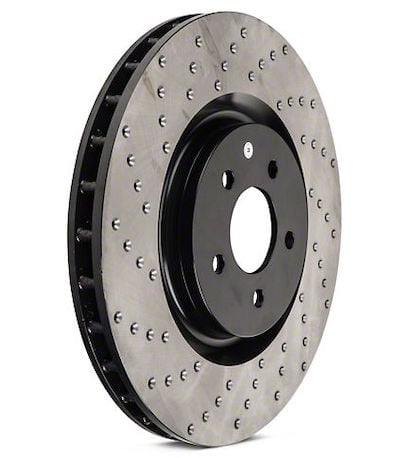
A drilled rotor is also called a cross-drilled rotor. Drilled rotors have holes drilled all the way through from the front to the back. This design keeps the rotor as cool as possible.
Out of all the rotor designs out there, drilled rotors have the most surface area. This isn’t obvious at first, but each hole creates additional surface area that can shed heat. This means drilled rotors can dissipate heat better than any other rotor design. Because of that, drilled rotors offer better braking performance in all kinds of situations. That includes towing and racing.
The Pros Of Using Drilled Rotors
Drilled rotors have the same benefits as slotted rotors, but to greater extent. The holes keep the pad and rotor surfaces clean and clear of dirt and moisture. This increases brake bite (and helps keep the brake performance in tip-top shape). Some drivers feel that drilled rotors perform better in wet conditions than any other rotor design.
Drilled rotors are lighter than traditional smooth rotors. Because of this, drilled rotors have lower rotational inertia. That means your vehicle can accelerate and stop faster with drilled rotors.
Drilled rotors maintain cooler operating temperatures, as well. It’s because the holes provide improved ventilation.
The Cons Of Using Drilled Rotors
Drilled rotors have the same drawbacks as slotted rotors. There’s the risk of early rotor and brake pad wear from jagged edges around the drilled holes. You can avoid this problem by buying high quality drilled rotors from us. We only carry drilled rotors from reputable brands. Check out our selection here!
What Is A Vented Rotor?

At a glance, a vented rotor looks like a traditional smooth rotor. It has a smooth surface. Yet, if you look at the side, you’ll see a major difference in design. Traditional smooth rotors are just solid discs. Vented rotors have hollow channels between the front and back surfaces. This design brings a couple of great benefits:
- It allows the rotor to shred heat faster
- It helps prevent brake fade
Essentially, vented rotors cool better and don’t fade as fast as solid rotors. Read this comparison guide to learn more about the differences between solid rotors and vented rotors.
The Pros Of Using Vented Rotors
Vented rotors bring several great benefits to the table:
- Better heat dissipation: Vented rotors shed heat faster than solid rotors.
- Longevity: Vented rotors generally last longer than solid rotors. They’re also less prone to cracking related to heat build up.
- Minimal brake pad wear: Smooth surfaces minimize brake pad wear. So vented rotors don’t wear out brake pads as fast as slotted and drilled rotors.
The Cons Of Using Vented Rotors
Compared to slotted and drilled rotors, the heat dissipation isn’t as good on vented rotors. It’s better than solid rotors, though. Another drawback of using vented rotors is that the vents can pick up contaminants, such as road salt, from the road. They can then spread the contaminants to the calipers.
Use These Rotors If…
A good way to determine the right type of rotors for your vehicle is to figure out your driving style and your vehicle’s purpose. Here are a few examples:
You Have A Daily Driver
Vented rotors are good for daily drivers. Outfitting a daily driver with slotted or drilled rotors is overkill. Vented rotors are a better option than traditional solid rotors. They dissipate heat better and don’t warp or fade as much as solid rotors.
You Have A Performance Car
Drilled or slotted rotors are great for performance cars. If you have a performance car, avoid solid rotors. Solid rotors won’t maximize your car’s braking performance. Instead, get drilled rotors, slotted rotors, or both drilled and slotted rotors. These rotors are made for performance driving.
You Have A Tow Vehicle
It’s important to have performance rotors on tow vehicles. Drilled and slotted rotors dissipate heat really well, which is critical in towing braking performance. Make sure you use slotted or drilled rotors that don’t have jagged edges. You don’t want your brake pads to wear out fast.
Do you need help determining the right rotors to buy? We’ll be happy to help! Contact us here, and we’ll get back to you ASAP.

